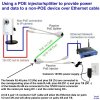The cameras are connect to tplink NVR. I have got 8 cameras C420I. And 4 pieces of C440W. The C440W cameras aren't working in Poe mode. They only work when connected with the DC power supply. They don't load in the NVR without DC power supply as well.
I bought few Poe splitter but they aren't doing anything.
Switches: Tplink TL-SF1009P
Camera: Tplink VIGI C440W
NVR: VIGI NVR R1016H 16 CHANNEL
On contacting tplink support, they confirmed these C440W cameras do not support POE power. But I need to fix the poe splitter issue.
I bought few Poe splitter but they aren't doing anything.
Switches: Tplink TL-SF1009P
Camera: Tplink VIGI C440W
NVR: VIGI NVR R1016H 16 CHANNEL
On contacting tplink support, they confirmed these C440W cameras do not support POE power. But I need to fix the poe splitter issue.




